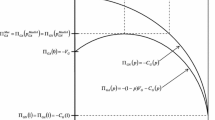Abstract
We present a novel model capable of distinguishing between the effects of negative incentives (“sticks”) and positive incentives (“carrots”) for influencing the behavior of intelligent and adaptable adversaries. Utilities are developed for the defender and the terrorist. The defender is assumed to have a unit cost of defense, and unit costs of providing negative and positive incentives. The terrorist likewise has a unit cost of attack, which may either increase or decrease if the defender provides negative incentives, and enjoys a unit benefit of positive incentives. We show that the potential for perverse effects of counterterrorism (e.g., the emergence of hatred) can cause defenders to rely on positive incentives and decrease their reliance on negative incentives at equilibrium, with use of negative incentives completely eliminated in situations where these would be moderately effective when applied. With low potential for perverse effects of counterterrorism, the defender should rely on effective negative incentives.
Similar content being viewed by others
References
Aumann, R., & Maschler, M. (1995). Repeated games with incomplete information. Cambridge: MIT Press.
Bandyopadhyay, S., & Sandler, T. (2011). The interplay between preemptive and defensive counterterrorism measures: A two-stage game. Economica. doi:10.1111/j.1468-0335.2009.00823.x.
Bier, V. M., Oliveros, S., & Samuelson, L. (2007). Choosing what to protect: strategic defensive allocation against an unknown attacker. Journal of Public Economic Theory, 9, 563–587.
Brock, P. (1999). Varieties of pacifism: A survey from antiquity to the outset of the twentieth century. New York: Syracuse University Press.
Burton, F. (2008). Ghost: confessions of a counterterrorism agent. New York: Random House.
Dalvi, N., Domingos, P., Mausam, M., Sanghai, S., & Verma, D. (2004). Adversarial classification. In Proceedings of the 2004 ACM SIGKDD international conference on knowledge discovery and data mining, Seattle, WA (pp. 99–108).
Dirks, T. (1969), Review of “Butch Cassidy and the Sundance Kid (1969)”, http://www.filmsite.org/butc3.html.
Enders, W., & Sandler, T. (2004). What do we know about the substitution effect in transnational terrorism. In A. Silke & G. Ilardi (Eds.), Research on terrorism: trends, achievements and failures. London: Frank Cass.
Frey, B. S. (2004). Dealing with terrorism: stick or carrot. Northampton: Edward Elgar.
Frey, B. S., & Luechinger, S. (2003). How to fight terrorism: alternatives to deterrence. Defense and Peace Economics, 14, 237–249.
Ganor, B. (2005). The counter-terrorism puzzle: a guide for decision makers. New Brunswick: Transaction Publishers.
Glaeser, E. L. (2005). The political economy of hatred. Quarterly Journal of Economics, 120, 45–86.
Hausken, K. (2006). Income, interdependence, and substitution effects affecting incentives for security investment. Journal of Accounting and Public Policy, 25, 629–665.
Hobbes, T. (1651). Leviathan. London: Dent.
Hoffman, B. (1998). Inside terrorism. New York: Columbia University Press.
Hoffman, B. (2001), All you need is love, The Atlantic, http://www.theatlantic.com/doc/200112/hoffman.
Hirshleifer, J. (1995). Anarchy and its breakdown. Journal of Political Economy, 103, 26–52.
Keohane, N., & Zeckhauser, R. J. (2003). The ecology of terror defense. Journal of Risk and Uncertainty, 26, 201–229.
Lakdawalla, D., & Zanjani, G. (2005). Insurance, self-protection, and the economics of terrorism. Journal of Public Economics, 89, 1891–1905.
Lutfi, A. (2001). Blowback: China and the Afghan Arabs. Issues and Studies, 37(1), 160–214.
Obama, B. H. 2009. The Nobel peace prize lecture, Oslo, December 10, 2009, http://nobelprize.org/nobel_prizes/peace/laureates/2009/obama-lecture_en.html.
Machiavelli, N. (1492). The prince. Cambridge: Cambridge University Press.
Pruitt, D. G. (2006). Negotiation with terrorists. International Negotiation, 11(2), 371–394.
Salop, S. C., & Scheffman, D. T. (1983). Raising rivals’ costs. American Economic Review, 73, 267–271.
Sandler, T., Arce, D. G., & Enders, W. (2008). Copenhagen consensus 2008 challenge paper: terrorism.
Schelling, T. (1960). The strategy of conflict. Cambridge: Harvard University Press.
Schelling, T. (1978). Micromotives and macrobehavior. New York: Norton.
Skaperdas, S. (1996). Contest success functions. Economic Theory, 7, 283–290.
Spector, B. I. (1998). Deciding to negotiate with villains. Negotiation Journal, 14(1), 43–59.
Spector, B. I. (2003). Negotiating with villains revisited: research note. International Negotiation, 8(3), 616–626.
Tzu, S. (320 Before Christ). The art of war. Translated by Griffith, S.B. (1963). London: Oxford University Press.
Tirole, J. (1989). The theory of industrial organization. New York: MIT Press.
Tullock, G. (1967). The welfare costs of tariffs, monopolies, and theft. Western Economic Journal, 5, 224–232.
Author information
Authors and Affiliations
Corresponding author
Rights and permissions
About this article
Cite this article
Bier, V.M., Hausken, K. Endogenizing the sticks and carrots: modeling possible perverse effects of counterterrorism measures. Ann Oper Res 186, 39–59 (2011). https://doi.org/10.1007/s10479-010-0833-8
Published:
Issue Date:
DOI: https://doi.org/10.1007/s10479-010-0833-8




